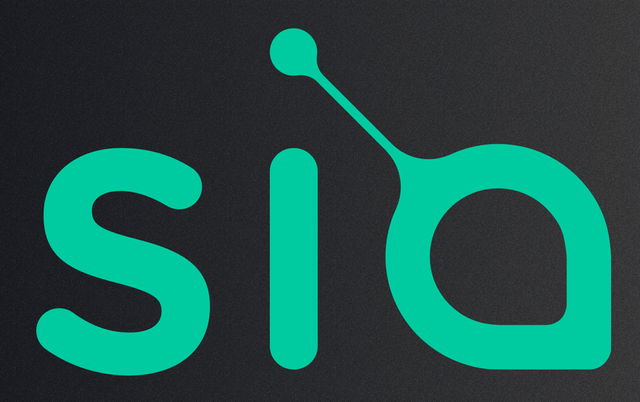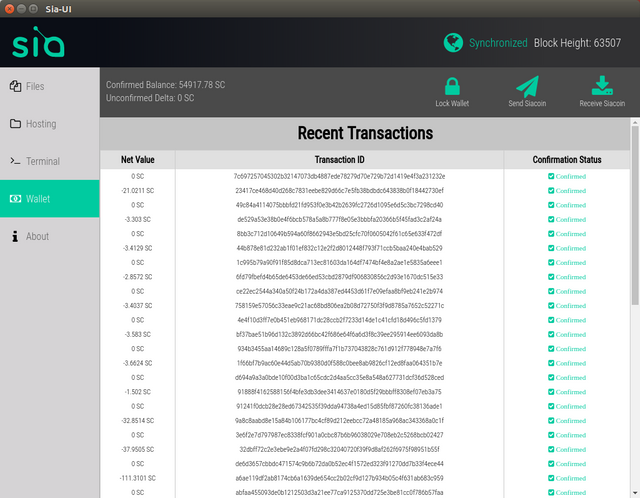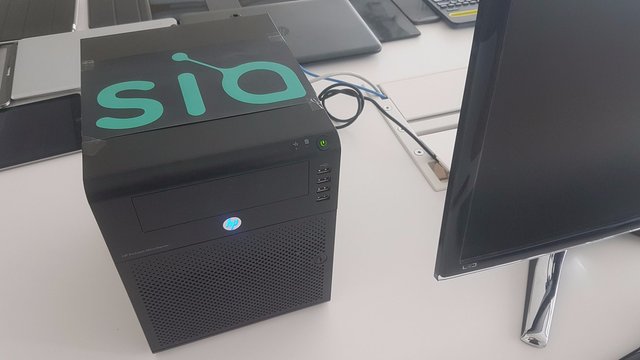Sia Review - Altcoin Fundamentals
The Whitepaper? We read it for you. That 194 page long ANN thread on Bitcointalk? Well, we tried. We stalked the developers on GitHub and we ran all the software. We even mined a few coins. Let’s start this series on Altcoins with a small project that has a big goal: Sia wants to become the backbone storage layer of the Internet.

The Project
Sia offers blockchain-secured, enterprise-grade, distributed and encrypted storage. Participants can either offer storage (“Farm”) or buy storage (“Store”). They can mine SiaCoin or develop their own applications on top of Sia’s technology.
At the time of writing, Sia-UI, the client for offering storage, buying storage and checking on your SiaCoin balance was at v1.0.2. Sia was hosting 430’000 file contracts, 25TB of storage space total. There were roughly 17 billion SiaCoins in circulation. The network’s hash rate was at 10,5GH/s.
The Economy
The number of SiaCoins created with each block is (300’000 - height). After height 270’000, all blocks will have a reward of 30’000 SiaCoins. Sia’s block time is 10 minutes. The Sia developers declared that they have mined “the first 100 blocks” before releasing the code and miner to the public.
Coin growth supply, according to the Whitepaper:
| Year | Growth |
|---|---|
| 1 | 90% |
| 2 | 39% |
| 3 | 21% |
| 4 | 11.5% |
| 5 | 4.4% |
| 8 | 3.2% |
| 20 | 2.3% |
A second token, Siafund is used to finance the ongoing development of the project. 3.9% of all storage contract revenues are paid out to Siafund holders. There are 10’000 Siafunds in total, 8’750 are held by the developers, the rest was sold to early adopters to fund initial development.
Money primarily enters the ecosystem through the purchase of storage contracts, which are currently at about $2.25/TB/month, significantly below competitors like S3: $29/TB/month or Dropbox: $9.9/TB/month.
Overall, the SiaCoin/Siafund ecosystem seems simple, yet well constructed to offer the right incentives for sellers and buyers of storage, for miners and for the Sia developers. Siafund is a clever idea to insulate the developers from the volatile public Altcoin markets.
From a fundamental perspective, the valuation of SiaCoin (and indirectly also the value of Siafund) will depend on storage contract growth, which will probably take quite some time and development effort to pick up.
At low contract volumes, there’s the risk of Siafund not supporting the development efforts sufficiently, resulting in a situation where the developers will have to look for additional sources of income. At high contract volumes, miners might feel cheated out of a fair reward because their mining proceeds do not depend on contract volume (however, since such a situation will probably also lead to an increase in the valuation of SiaCoin, this problem should be minor). For storage buyers and sellers, the fluctuation of SiaCoin is a source of uncertainty (Sia plans to install a two-way peg to Bitcoin in the future), the same is true for the need to negotiate storage contracts. The negotiation/handling of storage contracts doesn’t look like something end-users (individuals or companies) should be doing and we hope that for common use cases, a solution will emerge that moves storage contract negotiation to the network or to a third party, e.g. a service providing storage cost arbitrage (inside the network and vs. the US Dollar), handing out storage for a fixed price as a result.
The Developers
The company behind Sia is Nebulous Inc. The Sia developers seem to be a bit shy, no dev CVs are available on the Sia website and we didn’t find a company website for Nebulous Inc. On GitHub, Nebulous currently lists five People:
- David Vorick (CEO): BS from Rensselaer Polytechnic Institute, previous work experience: intern at IBM, roughly 26 years old
- Johnathan Howell (Designer, working at Microsoft): M.A. from Savannah College of Art and Design, 27
- Luke Champine (Co-Founder): BS from Rensselaer Polytechnic Institute, Previous work experience: intern at Akamai, roughly 26
- Jane Maunsell (Software Engineering Intern)
- Jordan Horwich (Software Engineer), BS from Rensselaer Polytechnic Institute
- Ming Luo, former intern
The developers are active on social media, especially Dave is in regular exchange with the community on Bitcointalk, Reddit and Sia’s own forum.
Sia’s team might not bring decades of experience in the storage industry to the table, but they’ve been at this for quite some time now. Their clear focus, serious work ethics (judging from the frequency/reliability of their Git commits), no bullshit approach to tech (again, judging from GitHub and public statements) are more than promising. David’s well reflected social media contributions inspire confidence in the team’s courageous commitment to building the soon to be best storage product on the market.
The Community
Sia is currently still a small project (even for Altcoin standards) and since it’s obviously backed by a company, community participation is quite weak. The lack of a very vocal support community might actually be a good thing for a project with such a clear focus and roadmap: community can be a big distraction in the Altcoin world, especially if it consists of hopeful/fearful bag-holders retained from a botched ICO. In the special case of Sia, a few people making serious contributions seem more valuable than a large group superficially promoting the project.
End-User Experience
Sia-UI promises to be a simple, central point of interaction for end-users.

Nevertheless, interacting with the network comes with high barriers of entry for non-crypto users:
- Offering storage requires users to deposit a minimum of 50’000 SiaCoins, a measure to prevent sybil attacks. This is a substantial barrier of entry, especially given the fact that the default contract configuration suggests revenues of only 1’000 SiaCoin per TB per month. A typical new user will have to organize Bitcoins, convert them to SiaCoins (at an exchange, for which he’ll probably have to open an account) and transfer those SiaCoins to his Sia wallet before he can start making money. He’ll have to invest maybe 50 month’s worth of potential revenue before he can start offering his excess storage for very little money. We hope that Sia will find a more user friendly way for storage providers to enter the network.
- Buying storage comes with the same, but in this case more obviously required, hurdle of organizing SiaCoins. Files can be stored by uploading them in Sia-UI. We have not found an easily accessible file system connector or some other elegant method to store information in Sia the “Dropbox” way. Sia will be confronted with the challenge of providing such connectors for various operating system if it wants to increase adoption by end users.
Sia is targeting enterprise customers and once the system is working at this scale, such barriers of entry would probably not hinder a committed IT administrator to use it. But as long as Sia is still a beta product with lots of promise, it will have to rely on the goodwill of true believers to prove its point and those will hardly be ready to go through all that hassle AND commit their IT resources for a minimum of 23 weeks, at high barriers of entry and high penalties for an early exit.

After a week, our sweet little Sia rig was able to sell 1GB of storage for 750SC/TB/Month (150GB offered). We also bought some storage and found the uploads and downloads to be quite slow, minutes for megabytes on a gigabit line.
Limitations aside, Sia-UI provides a nicely presented first point of access to the network. Given the fact that v1 was released roughly two months ago at the time of writing, Sia-UI is an astonishingly mature proof of concept/MVP release.
Likely, Sia-UI will remain just that, a proof of concept, and the developers will focus on providing a solid storage API, similar or equal to Amazon’s S3 API, while relying on others to come up with more user-friendly front-end solutions.
Conclusion
Distributed storage is a surprisingly hard to solve problem. Sia could fail to do so, or it could become hugely successful precisely because of that razor sharp focus. We started our series with a project that we liked because it a has a clear promise and doesn’t go for the “future at large” approach common with many other blockchain offerings. Plagued by the fundamental insecurity of Dropbox, we’d be happy to see Sia succeed.
We plan to continue this series and to eventually review most of the current crypto projects from a fundamentals perspective. Tell us what you think about Sia, what kind of info you’d like to see in our reviews and of course what kind of projects you’d like us to review.
Facts at the Time of Writing
| Name | Explanation |
|---|---|
| Project URL | http://sia.tech/ |
| Network status URL | https://explore.sia.tech/ |
| More network info | http://siapulse.com/ |
| Company | Nebulous Inc. |
| Direct/indirect competitors | Storj, MaidSafe |
| Market cap | 10’914’611 US$ |
| Announced (bitcointalk.org) | May 14th, 2015 |
| Network launch | June 2015 |
| Client V1 | June 2016 |
| Next milestone | Amazon S3 API Compatibility |
| Blockchain type | Proof of Work + Storage Contracts |
| Hashing algo | blake2b |
| Block reward | 300’000 - height, 30’000 constant after height 270’000 |
| Block time | 10 minutes |
| Stored on the blockchain | storage contracts and contract updates, proof of storage, transactions |
| Coins available | 19.7 Billion SC |
| Listed at | Poloniex, Yunbi |
| Coins total | infinite |
Nice one man. I upvoted. Check out my channel as well for more altcoin videos.
Dear User known as @iainc
Steemit has a BOT problem! Your Vote Counts... Maybe
https://steemit.com/steemit/@weenis/bots-steemit-s-first-community-based-decision-on-bots-your-vote-counts-to-be-or-not-to-be-details-inside
Thanks for the in depth review. I'm very interested in all of the different distributed block chain based storage solutions coming out right now. I've been thinking about building a storage rig. Really great article, keep it up.
Thanks! Storj will be next. MaidSafe maybe a little later when there's more to see. Do you know of any other "pure storage" plays?
no, those three are the ones i've been hearing about.
Nice thorough review! One inaccuracy: two-way peg with bitcoin is no longer planned (the whitepaper is somewhat dated). Also, you can trade Siacoin on Cryptomic.com and BitSquare (a decentralized exchange I highly recommend everyone to check out).
Thanks for the hint! I tried updating the text, but apparently that is no longer possible after a certain amount of time. I like BitSquare a lot and hope that it will gain the traction it needs to provide the volume necessary for trading. ShapeShift should probably be mentioned too in this context.
I really like that project, hold a lot of coins. Also want to start mine!
I think SiaCoin has a great idea offering blockchain decentralized storage, use of contracts for storage rental, use of SiaCoin to generate payment and a mechanism to promote use of the altcoin. It seems if you want to offer storage this needs to be done with their Minebox (or Sia-Rig as you put it). I'm curious to know, regardless of contracts specifics, how SiaCoin and mine-box data storage providers guarantee "quality of service"? While most users would just keep their mine-box running 24/7/365, what stops a user from power it down for a prolong period or is it specified in the contract. What happens if the minebox fails, does SiaCoin rush a new box to the client providing contracted services, and mines data from the old box (even if data is decentralized-some of the data would still be inaccessible)? How can SiaCoin guarantee quality of the "minebox providers' internet service"? While most places have cable-modem/DSL, there are areas even in the most advanced areas of the world that are challenged with poor ISP provisions. I can only assume that enough redundancy is provided within the solution, that if a minebox went down, that the data is striped/or parity info. available or mirrored somewhere else? I guess i have scalability, redundancy, QoS, load-balancing, and other items like this on my mind when looking at SiaCoin's solution. I really do like what they've got going on.
The review is good, thank you so much
SIA will be the future of storage.
i totally agree!!! prolly around 5 years from now!
I really appreciated your review of Sia, always interested in hearing about innovative uses for blockchain technology. I'd like to see a review (and explanation!) of Tauchain/Agora's Token. This is somewhat mystifying technology to me, but I always hear how groundbreaking it is.
Thanks for the hint, we'll have a closer look, especially once there's a little more to see. I stumbled upon the idni.org website some time ago and my first impression was that the promises made there are a bit too advanced to be realistic - mystifying sounds just about right. It's like the developers (a single guy?) are/is promising to solve all of IT's unsolved theoretical and practical problems in the next few years.
Hey there, nice article. Do you know if it's possible to not keep the entire Sia blockchain in your HD since it takes up a lot of disc space. Is it possible to keep the blockchain in an external HD? Thanks!